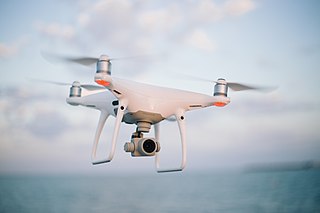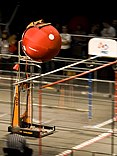
An unmanned aerial vehicle (UAV), commonly known as a drone, is an aircraft without any human pilot, crew, or passengers on board. UAVs were originally developed through the twentieth century for military missions too "dull, dirty or dangerous" for humans, and by the twenty-first, they had become essential assets to most militaries. As control technologies improved and costs fell, their use expanded to many non-military applications. These include aerial photography, precision agriculture, forest fire monitoring, river monitoring, environmental monitoring, policing and surveillance, infrastructure inspections, smuggling, product deliveries, entertainment, and drone racing.

Swarm robotics is an approach to the coordination of multiple robots as a system which consist of large numbers of mostly simple physical robots. ″In a robot swarm, the collective behavior of the robots results from local interactions between the robots and between the robots and the environment in which they act.″ It is supposed that a desired collective behavior emerges from the interactions between the robots and interactions of robots with the environment. This approach emerged on the field of artificial swarm intelligence, as well as the biological studies of insects, ants and other fields in nature, where swarm behaviour occurs.

A quadcopter, also called quadrocopter, or quadrotor is a type of helicopter that has four rotors.

FIRST Tech Challenge (FTC), formerly known as FIRST Vex Challenge, is a robotics competition for students in grades 7–12 to compete head to head, by designing, building, and programming a robot to compete in an alliance format against other teams. FIRST Tech Challenge is one of the four major robotics programs organized by FIRST, which its other three programs include FIRST Lego League Explore, FIRST Lego League Challenge, and FIRST Robotics Competition.

Botball is an educational robotics program that focuses on engaging middle and high school aged students in team-oriented robotics competitions. Thousands of children and young adults participate in the Botball program. It has been active since 1998 and features a robotics curriculum which focuses on designing, building and programming a pair of autonomous robots. Teams use a standardized kit of materials, document the process and then compete in a tournament in which the challenges change annually. All materials in the kits are exactly the same for every team around the world, so there are no unfair advantages. Botball teams are mostly based in the United States with over 300 teams and local tournaments in more than a dozen regions. In recent years it also holds an annual Global Conference on Educational Robotics (GCER), with an international tournament that attracts teams all over the country as well as from Mexico, Austria, China, Uganda, Poland, Qatar, Kuwait, Egypt, and many others.

The FIRST Championship is a four-day robotics championship held annually in April at which FIRST student robotics teams compete. For several years, the event was held at the Georgia Dome in Atlanta, Georgia, but moved to the Edward Jones Dome in St. Louis, Missouri in 2011, where it remained through 2017. In 2017, the Championship was split into two events, being additionally held at the George R. Brown Convention Center and Minute Maid Park in Houston, Texas. In 2018 and 2019, the Championship was held in Houston and Detroit, Michigan at the TCF Center and Ford Field. The event comprises four competitions; the FIRST Robotics Competition Championship, the FIRST Tech Challenge World Championship, the FIRST Lego League World Festival, and the FIRST Lego League Junior World Expo.

The Midwestern Robotics Design Competition (MRDC) is an annual student-run robotics competition held every March at the University of Illinois Urbana-Champaign (UIUC), where participant teams compete with self-constructed robots in an annual game objective. The competition was first held in 1987 and is one of the oldest continuing robotics competitions in the United States. Prior to 2016, it was named the AMD Jerry Sanders Creative Design Competition (JSDC) after Jerry Sanders, a University of Illinois alumnus and the co-founder and former long-time CEO of AMD.

Lunacy is the game for the 2009 FIRST Robotics Competition. Announced on January 3, 2009, the name and some of the features of the game honor the 40th anniversary of the first human mission to the Moon. It is FRC's 18th game. This is the first FRC competition to use the cRIO Mobile Device Controller control system from National Instruments. The driver station introduced for 2009 was the Kwikbyte DS, which was replaced in 2010 by the Classmate PC.
Breakaway is the game for the 2010 FIRST Robotics Competition, announced on January 9, 2010. Robots direct soccer balls into goals, traverse "bumps" in the field, suspend themselves and each other on towers, and/or go through a tunnel located in the center of the field.

Aeryon Scout is a small reconnaissance unmanned aerial vehicle (UAV) that was designed and built by Aeryon Labs of Waterloo, Ontario, Canada. The vehicle was developed between 2007 and 2009 and produced from 2009-2015. Production has been completed and it is no longer advertised for sale on the company website.

Logo Motion is the 2011 FIRST Robotics Competition game. Playing pieces are inner tubes shaped like the components of the FIRST logo. The primary objective of the game is to place them on racks to gain points. In the endgame, robots deploy smaller robots ("minibots") to climb a tower. Minibots must be made from the FIRST Tech Challenge kit of parts. The game celebrates the 20th season of the FRC and is also meant to commemorate the artist Jack Kamen, who designed the original FIRST logo.

MikroKopter is a German company, a subsidiary of HiSystems GmbH, that manufactures battery-powered radio-controlled unmanned aerial vehicles. The company is located in Moormerland, Leer District, in Lower Saxony.
ArduPilot is an open source, unmanned vehicle Autopilot Software Suite, capable of controlling autonomous:

Aerial Assist was the 2014 FIRST Robotics Competition game.

Raffaello D’Andrea is a Canadian-Italian-Swiss engineer, artist, and entrepreneur. He is professor of dynamic systems and control at ETH Zurich. He is a co-founder of Kiva Systems, and the founder of Verity, an innovator in autonomous drones. He was the faculty advisor and system architect of the Cornell Robot Soccer Team, four time world champions at the annual RoboCup competition. He is a new media artist, whose work includes The Table, the Robotic Chair, and Flight Assembled Architecture. In 2013, D’Andrea co-founded ROBO Global, which launched the world's first exchange traded fund focused entirely on the them of robotics and AI. ROBO Global was acquired by VettaFi in 2023.

3DR is an American company located in Berkeley, California that produces enterprise drone software for construction, engineering and mining firms, as well as government agencies.
VEX Robotics is a robotics program for elementary through university students and a subset of Innovation First International. The VEX Robotics competitions and programs are managed by the Robotics Education & Competition Foundation (RECF). In April 2018, VEX Robotics Competition was named the largest robotics competition in the world by Guinness World Records.

The Composite Engineering BQM-167 Skeeter is a subscale aerial target (drone) developed and manufactured by Composite Engineering Inc. and operated by the United States Air Force and certain international customer air forces. It replaced the Beechcraft MQM-107 Streaker.

RoboMaster is an annual intercollegiate robot competition held in Shenzhen, Guangdong, China, founded and hosted by the drone tech giant DJI. First started in 2015, it is the brainchild of DJI's founder and CEO Frank Wang, and jointly sponsored by the Communist Youth League Central Committee, the All-China Students' Federation (ACSF) and the Shenzhen City Government. It is the first shooting sport-style robotics competition in China.
The Robotics Education & Competition Foundation is a 501(c)(3) non-profit organization best known for managing competitions and programs for the VEX Robotics Competition. Over 1.1 million students have participated in RECF programs around the world. The organization’s mission is to provide more students with the opportunity to engage in STEM.

















